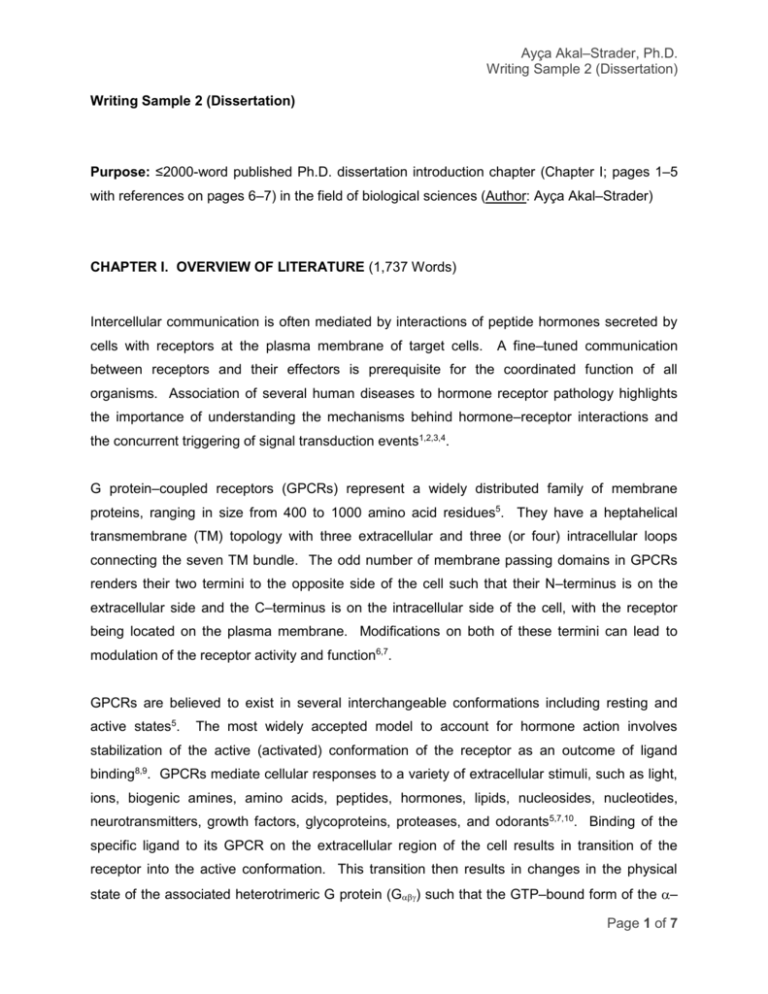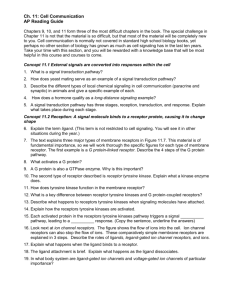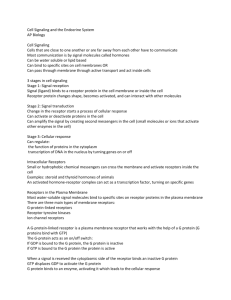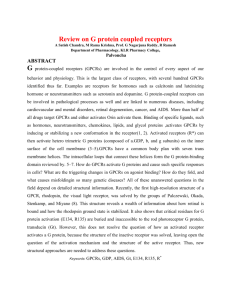Writing Sample 2 (Dissertation)
advertisement

Ayça Akal–Strader, Ph.D. Writing Sample 2 (Dissertation) Writing Sample 2 (Dissertation) Purpose: ≤2000-word published Ph.D. dissertation introduction chapter (Chapter I; pages 1–5 with references on pages 6–7) in the field of biological sciences (Author: Ayça Akal–Strader) CHAPTER I. OVERVIEW OF LITERATURE (1,737 Words) Intercellular communication is often mediated by interactions of peptide hormones secreted by cells with receptors at the plasma membrane of target cells. A fine–tuned communication between receptors and their effectors is prerequisite for the coordinated function of all organisms. Association of several human diseases to hormone receptor pathology highlights the importance of understanding the mechanisms behind hormone–receptor interactions and the concurrent triggering of signal transduction events1,2,3,4. G protein–coupled receptors (GPCRs) represent a widely distributed family of membrane proteins, ranging in size from 400 to 1000 amino acid residues5. They have a heptahelical transmembrane (TM) topology with three extracellular and three (or four) intracellular loops connecting the seven TM bundle. The odd number of membrane passing domains in GPCRs renders their two termini to the opposite side of the cell such that their N–terminus is on the extracellular side and the C–terminus is on the intracellular side of the cell, with the receptor being located on the plasma membrane. Modifications on both of these termini can lead to modulation of the receptor activity and function6,7. GPCRs are believed to exist in several interchangeable conformations including resting and active states5. The most widely accepted model to account for hormone action involves stabilization of the active (activated) conformation of the receptor as an outcome of ligand binding8,9. GPCRs mediate cellular responses to a variety of extracellular stimuli, such as light, ions, biogenic amines, amino acids, peptides, hormones, lipids, nucleosides, nucleotides, neurotransmitters, growth factors, glycoproteins, proteases, and odorants5,7,10. Binding of the specific ligand to its GPCR on the extracellular region of the cell results in transition of the receptor into the active conformation. This transition then results in changes in the physical state of the associated heterotrimeric G protein (G) such that the GTP–bound form of the – Page 1 of 7 Ayça Akal–Strader, Ph.D. Writing Sample 2 (Dissertation) subunit dissociates from both the receptor and the stable dimer. Both the GTP–bound – subunit and the released dimer can modulate diverse cascades of intracellular signal transduction pathways such as stimulation or inhibition of adenylate cyclases, activation of phospholipases, and regulation of activity of protein kinases and K+ and Ca2+ ion channels, thereby culminating in differential gene transcription and characteristic phenotypic changes in cellular physiology to meet the current needs of the cell6,7,11,12. GPCRs are therefore the key controllers of such diverse physiological processes as neurotransmission, cellular metabolism, secretion, cellular differentiation, growth, sensation to light, odors, taste, and pain as well as inflammatory and immune responses7,10. Due to their participation in such diverse pathways, GPCRs play a very important role in the fate of the cell and are therefore present in all organisms from prokaryotes to the single–celled yeast and multicellular higher eukaryotic organisms such as plants and humans13. Based on hydrophobicity analyses more than 25% of all proteins coded in genomes is represented by membrane proteins14 and the human genome encodes more than 1,000 receptors15, which comprises >1% the human genome16. The diversity of ligands that can bind GPCRs, striking differences in the sites and modes of ligand binding and signal generation, as well as the occurrence of multiple classes of receptors in the GPCR superfamily render them by far the largest family of receptors known to date6,17,18. These diversities indicate the availability of numerous alternative approaches to clinical and industrial applications17. While GPCRs do not share any overall sequence homology, significant sequence homology is found within several subfamilies. Based on certain key sequences, GPCRs are categorized into six major families from A to F7,19. Family A receptors include the light–receptor of the visual system rhodopsin and the 2–adrenergic receptors. Family B contains receptors that are related to the glucagon receptor and family C comprises receptors related to the metabotropic neurotransmitter receptors. The two minor yet unrelated families D and E are formed by the fungal yeast Saccharomyces cerevisiae pheromone receptors Ste2p and Ste3p. Finally, yet another minor but unique subfamily of proteins comes from Dictyostelium discoideum to form the four cAMP receptors of family F. Among these, the rhodopsin/2–adrenergic receptors of family A form by far the largest superfamily of receptors with over 700 members that contain receptors for odorants, small molecules such as cathecolamines and amines, some peptides, and glycoprotein hormones7,15,19. Page 2 of 7 Ayça Akal–Strader, Ph.D. Writing Sample 2 (Dissertation) Numerous loss–of–function, heterozygous, inactivating and constitutively activating mutations, as well as polymorphisms, lack of expression, mislocalization, failure in attaining the correct oligomeric states, truncations, and splice variants have been observed in GPCRs that relate to a wide spectrum of hereditary and somatic disorders and several disease states from cancer to infertility1,6,15,17. It is not unanticipated that GPCRs represent major targets for development of new drug candidates with potential application in all clinical fields10. Understanding the broad range of physiological functions and the modes of regulation associated with GPCRs can therefore provide a solid foundation for novel therapeutic interventions in a variety of diseases1,15. It is not surprising that over 50% of all modern drugs and almost one–quarter of the top 100–200 best–selling drugs modulate GPCRs activity15,20. Given the overall common structural features among GPCRs, a detailed structural analysis using x–ray crystallography should bring insights into determinants of ligand binding and mechanisms of receptor activation. However, due to low natural abundance, difficulty in producing and purifying significant quantities of recombinant protein, and inherent difficulties in solubilizing and obtaining well–diffracting crystals of the large, membrane–bound, lipid– associated GPCRs, such studies have been severely impeded9. A noted exception is rhodopsin for which a high–resolution crystallographic structure has been determined21. A crystal structure of the extracellular ligand–binding domain of the metabotropic glutamate receptor with and without the ligand has also been reported22. The paucity of crystallographic structural information on other GPCRs hampered determinations of ligand–receptor interactions and the events leading to the concurrent activation of the signal transduction pathway. An alternative to detailed crystallographic information on GPCRs has therefore been the analysis of mutant receptors for structure–function studies. One area of intense study has been to determine the ligand binding site as a means to understanding different states of receptors and how the occupation by ligand may initiate signal transduction. Results from such studies are then correlated to the structure of rhodopsin. However, caution needs to be used in such comparisons because rhodopsin has its ligand retinal covalently attached to itself while all other known GPCRs have external ligands. Therefore, other GPCRs, including those that belong to the same subfamily as rhodopsin can structurally differ from rhodopsin. Page 3 of 7 Ayça Akal–Strader, Ph.D. Writing Sample 2 (Dissertation) Studying GPCRs in higher organisms presents great challenges due to multiple classes of GPCRs and multiple subtypes of the same GPCR present in the same cell or the same tissue. This becomes even more complicated when the same GPCR can bind a variety of different ligands to modulate several different physiological pathways. One of the organisms to rise to the challenge of serving as a good model system to study receptor–ligand interactions has been the single–celled yeast Saccharomyces cerevisiae (reference 11 and see below). Based on the completion of sequencing of its whole genome, S. cerevisiae contains only three GPCRs, two of them being the pheromone receptors Ste2p and Ste3p, and the third being Gpr1p, which is a carbohydrate nutrient sensor23. Yeast can exist either as a diploid or as a single haploid cell of the type a or and both the haploid and the diploid forms of yeast can be maintained easily given the right conditions. Haploid a cells secrete the a–factor pheromone, while haploid cells secrete the –factor pheromone. The two pheromones, –factor and a– factor, then bind to their cognate GPCRs, Ste2p and Ste3p, respectively, located on the opposite cell type. This reciprocal interaction of the two pheromones with their corresponding receptors results in the initiation of a protein kinase–mediated cascade of mating pheromone signal transduction leading to a change in cell morphology, growth arrest, and activation of a number of pheromone–responsive genes in preparation for cellular mating and sexual conjugation of the a and cells13,24,25,26,27,28. Since in any haploid cell there is only one of the pheromone receptors present, and the Gpr1p receptor couples to a different G protein (Gpa2p versus the Gpa1p in the pheromone receptors; reference 23), there is no cross–talk between these GPCRs. Thus, the interactions between the pheromone receptor and its pheromone ligand can be studied with great ease and specificity in yeast. Moreover, the complex but well-understood mating signal transduction pathway of yeast involves a MAPK pathway29, which shares several common features that are conserved in higher eukaryotic organisms such as humans. Yeast is also a very easy organism to work with due to ease of growing and handling both the stable haploid and the stable diploid forms, and the ability to use complex, powerful genetic manipulations. All these properties of yeast consequently render it a good model organism for studying and understanding receptor– ligand interactions11,13. In my studies, I have chosen to work in the mating type MATa cells where the pheromone receptor located on the cell surface is Ste2p and its corresponding pheromone ligand is the Page 4 of 7 Ayça Akal–Strader, Ph.D. Writing Sample 2 (Dissertation) tridecapeptide –factor. My studies favored this system over Ste3p/a–factor because the dodecapeptide a–factor mating pheromone is very hydrophobic and hard to handle due to carboxymethylation and farnesylation of its Cys residue located at position 12 on the C– terminus of the peptide. On the other hand, –factor is not as hydrophobic and thus is easily synthesized and manipulated to meet the needs of our investigations. Studies that I present in this dissertation focus on residues located at specific positions on the extracellular and transmembrane regions of the Ste2p receptor. My approach has been to mutagenize the receptor and then study the effects these mutations had on the function of the receptor. Part II details all the methodologies used throughout the dissertation. Part III describes scanning mutagenesis and characterization of the first and third extracellular loop (EL1 and EL3) residues of Ste2p. Part IV depicts studies on the mutant receptors with signal– deficient phenotypes that were identified in Part III. In these studies, mutations from EL1 and EL3 causing signal–deficient phenotypes are introduced into a receptor with a previously incorporated constitutively activating mutation, and the biological properties of the resultant mutants are investigated. Part V describes studies aimed at determining specific interactions between residues located on the transmembrane region of Ste2p that were predicted to interact with one another. Finally, Part VI gives the overall summary of the results along with some future directions, and the synopsis of my current understanding of Ste2p based on the studies presented herewith. Page 5 of 7 Ayça Akal–Strader, Ph.D. Writing Sample 2 (Dissertation) REFERENCES: 1. Edwards SW, Tan CM and Limbird LE (2000) "Localization of G-protein-coupled receptors in health and disease." Trends Pharmacol Sci 21:304-308 2. Dowell SJ (2001) "Understanding GPCRs - from orphan receptors to novel drugs." Drug Discov Today 6:884-886 3. Wise A, Gearing K and Rees S (2002) "Target validation of G-protein coupled receptors." Drug Discov Today 7:235-246 4. Lu ZL, Saldanha JW and Hulme EC (2002) "Seven-transmembrane receptors: crystals clarify." Trends Pharmacol Sci 23:140-146 5. Lefkowitz RJ (2000) "The superfamily of heptahelical receptors." Nat Cell Biol 2:E133-136 6. Schoneberg T, Schultz G and Gudermann T (1999) "Structural basis of G protein-coupled receptor function." Mol Cell Endocrinol 151:181-193 7. Gether U (2000) "Uncovering molecular mechanisms involved in activation of G proteincoupled receptors." Endocr Rev 21:90-113 8. Kenakin T (1997) "Agonist-specific receptor conformations." Trends Pharmacol Sci 18:416417 9. Gether U and Kobilka BK (1998) "G protein-coupled receptors. II. Mechanism of agonist activation." J Biol Chem 273:17979-17982 10. Hebert TE and Bouvier M (1998) "Structural and functional aspects of G protein-coupled receptor oligomerization." Biochem Cell Biol 76:1-11 11. Dohlman HG, Thorner J, Caron MG and Lefkowitz RJ (1991) "Model systems for the study of seven-transmembrane-segment receptors." Annu Rev Biochem 60:653-688 12. Schwartz TW (1996) Ch. 2: Molecular Structure of G-Protein-Coupled Receptors. Textbook of Receptor Pharmacology, CRC Press Inc.:65–84 13. Dohlman HG (2002) "G proteins and pheromone signaling." Annu Rev Physiol 64:129-152 14. Popot JL and Engelman DM (2000) "Helical membrane protein folding, stability, and evolution." Annu Rev Biochem 69:881-922 15. George SR, O'Dowd BF and Lee SP (2002) "G-protein-coupled receptor oligomerization and its potential for drug discovery." Nat Rev Drug Discov 1:808-820 16. Perez DM (2003) "The evolutionarily triumphant G-protein-coupled receptor." Mol Pharmacol 63:1202-1205 17. Ji TH, Grossmann M and Ji I (1998) "G protein-coupled receptors. I. Diversity of receptorligand interactions." J Biol Chem 273:17299-17302 Page 6 of 7 Ayça Akal–Strader, Ph.D. Writing Sample 2 (Dissertation) 18. Rana BK and Insel PA (2002) "G-protein-coupled receptor websites." Trends Pharmacol Sci 23:535-536 19. Fredriksson R, Lagerstrom MC, Lundin LG and Schioth HB (2003) "The G-protein-coupled receptors in the human genome form five main families. Phylogenetic analysis, paralogon groups, and fingerprints." Mol Pharmacol 63:1256-1272 20. Kroeze WK, Sheffler DJ and Roth BL (2003) "G-protein-coupled receptors at a glance." J Cell Sci 116:4867-4869 21. Palczewski K, Kumasaka T, Hori T, Behnke CA, Motoshima H, Fox BA, Le Trong I, Teller DC, Okada T, Stenkamp RE, Yamamoto M and Miyano M (2000) "Crystal structure of rhodopsin: A G protein-coupled receptor." Science 289:739-745 22. Kunishima N, Shimada Y, Tsuji Y, Sato T, Yamamoto M, Kumasaka T, Nakanishi S, Jingami H and Morikawa K (2000) "Structural basis of glutamate recognition by a dimeric metabotropic glutamate receptor." Nature 407:971-977 23. Lorenz MC, Pan X, Harashima T, Cardenas ME, Xue Y, Hirsch JP and Heitman J (2000) "The G protein-coupled receptor gpr1 is a nutrient sensor that regulates pseudohyphal differentiation in Saccharomyces cerevisiae." Genetics 154:609-622 24. Blumer KJ, Reneke JE, Courchesne WE and Thorner J (1988) "Functional domains of a peptide hormone receptor: the alpha-factor receptor (STE2 gene product) of the yeast Saccharomyces cerevisiae." Cold Spring Harb Symp Quant Biol 53 Pt 2:591-603 25. Konopka JB and Fields S (1992) "The pheromone signal pathway in Saccharomyces cerevisiae." Antonie Van Leeuwenhoek 62:95-108 26. Kurjan J (1992) "Pheromone response in yeast." Annu Rev Biochem 61:1097-1129 27. Sprague GFJaT, J. W. (1992) Gene Expression. The Molecular and Cellular Biology of the Yeast Saccharomyces. Cold Spring Harbor, NY, Cold Spring Harbor Laboratory Press. II:657–741 28. Banuett F (1998) "Signalling in the yeasts: an informational cascade with links to the filamentous fungi." Microbiol Mol Biol Rev 62:249-274 29. Ramezani-Rad M (2003) "The role of adaptor protein Ste50-dependent regulation of the MAPKKK Ste11 in multiple signalling pathways of yeast." Curr Genet 43:161-170 Page 7 of 7









